A visit to Mainz is a must when exploring Germany. Its location along the Rhine River and long history offer a unique blend of ancient and modern charm.

A view of Mainz across the Rhine river
Mainz has a rich history and culture that makes it a special place in Germany. It's the birthplace of Johannes Gutenberg and the revolutionary printing press. You can view this legacy first-hand in the city's museums and historical sites, which offer a chance to step back in time and see how mass communication began.
Mainz combines its historical roots with modern living. You'll find cobbled streets, half-timbered houses, modern shopping districts and busy marketplaces. The city's skyline, dominated by Mainz Cathedral, provides a stunning backdrop to cutting-edge research and innovative businesses.
Mainz's lively wine scene is another big draw. As the capital of the Rhineland-Palatinate region, known for its top wines, Mainz offers wine lovers a chance to enjoy some of Germany's best vintages. The city really comes alive during its many wine festivals, where locals and visitors alike get together to celebrate this important part of Mainz's identity.
Mainz is located in the western part of Germany in the Rhineland-Palatinate state, situated along the west bank of the Rhine River.
The historic city is approximately 40 kilometres west of Frankfurt and about 180 kilometres east of Luxembourg City. It is positioned at the confluence of the Main and Rhine rivers, which contributes to its strategic importance as a transportation hub.
Frankfurt Airport (FRA) is the closest major international airport to Mainz and is the best option for most travelers. It offers a wide range of flights from around the world and has excellent transport connections to Mainz.
Distance to Frankfurt Airport: 33km
Distance to Frankfurt Hahn Airport: 85km
Distance to Luxembourg Airport: 190km
Distance to Stuttgart Airport: 212km
Frankfurt Hahn Airport, despite its name, is actually on the other side of Mainz from Frankfurt. It's mainly used by budget airlines and can be an option for cost-conscious travelers, though the transfer to Mainz is slightly longer.
Luxembourg Airport, while further away, can sometimes be a good alternative, especially for those combining a visit to Mainz with travel in the Benelux countries.
Frankfurt Airport, being one of the busiest in Europe, offers the most extensive range of international and domestic flights. Its proximity and direct train connections make it the most convenient choice for most visitors to Mainz.
The main Mainz train station ('Mainz Hauptbahnhof') is located just southwest of the old town, within easy walking distance of the main sites and accommodation in the city center. It's also conveniently situated near the Rhine river.
Mainz is well-connected by rail, with frequent regional and long-distance services. Regular regional express trains connect Mainz to Frankfurt, Wiesbaden, and other cities in the Rhine-Main area. There are also direct InterCity and ICE (InterCity Express) connections to major German cities such as Berlin, Hamburg, Munich, and Cologne.
The busy Frankfurt-Mainz route is served by S-Bahn (suburban rail) services, providing frequent connections between the two cities. Additionally, there are regional train services along the Rhine valley, connecting Mainz with cities like Koblenz and Mannheim.
The German rail service offers a ticket ('Rheinland-Pfalz/Saarland-Ticket') which includes unlimited travel for a day on regional trains and bus services in the Rhineland-Palatinate and neighbouring Saarland. This can be a cost-effective option for travellers exploring the region around Mainz.
Mainz is ringed by a comprehensive motorway network allowing easy access to other major destinations in the region.
The A-60 motorway connects with Bingen to the west and, heading east, to the motorway network down to Mannheim and Heidelberg. The junction with the A-67 also allows access to Frankfurt Airport and then the city of Frankfurt itself.
The Mainz motorway ring can be used to reach the A-66 motorway in Wiesbaden on the other side of the Rhine river. This is an alternate way to drive to Frankfurt.
The B9 runs north along the western side of the Rhine past Bingen am Rhein to towns like Bacharach and Sankt Goar.
Most tourists find staying in the Altstadt ('Old Town') works best. It's the city centre, where you'll find most of the main attractions, restaurants and shops. You'll be able to walk to most places, which is a big plus. On the downside, It can be a bit pricier and noisier, especially during festivals.
If you're looking for somewhere quieter and more budget-friendly, you might want to consider staying in areas like Neustadt or Hartenberg-Münchfeld. They're a bit further out, but still well connected by public transport. You'll get more value for your money here and the chance to see what life is like in Mainz from a local perspective.
You'll find all the usual types of accommodation in Mainz, from fancy hotels to basic hostels. There are also some unique options. The Favorite Parkhotel is a bit of a luxury option, but it's set in a beautiful park and has a great restaurant.
If you know when you are planning to go but haven't decided on accommodation, then use the map below to get an idea of which properties are available and to compare prices during the period you wish to travel.
Enter your proposed dates and use the '+' to zoom in on a location and reveal more properties. Click on the price above a property to see more information.
(Please note that this selection will also include some guesthouses, pensions and self-catering apartments for those who are interested in that form of accommodation!)
Alternatively, if you would like a list of properties available on your proposed dates of travel, use the search box below to find accommodation:
Mogontiacum was founded around 13 BC and grew into a significant city. It was originally a Roman military camp but later became the capital of the province Germania Superior.
The Romans built plenty of infrastructure, including bridges, aqueducts and fortifications, some of which can still be viewed today.
Mainz really started to make a name for itself in the 8th century, thanks to Archbishop Boniface.
As an ecclesiastical state, the Electorate of Mainz was pretty powerful, with its archbishop one of the seven electors of the Holy Roman Emperor. This period saw the erection of a great many churches and the building of the famous Mainz Cathedral.
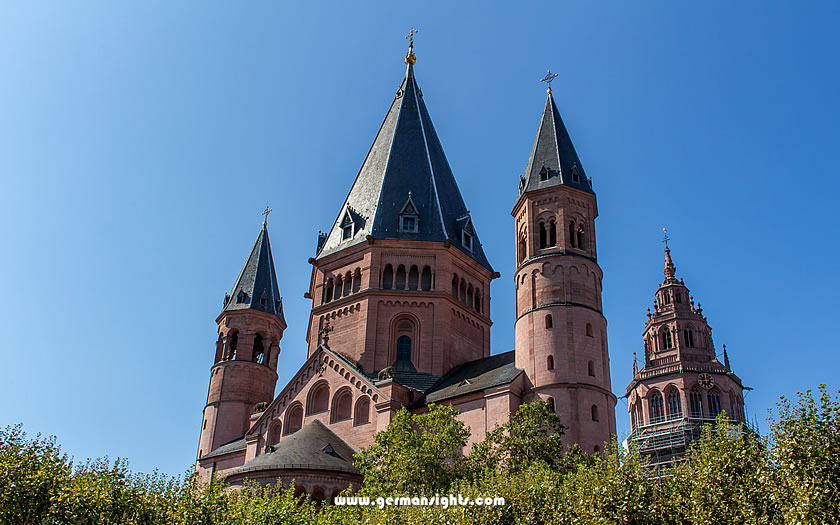
The cathedral of St Martin in Mainz
Johannes Gutenberg, who was born in Mainz around 1400, changed the way we communicate forever with his invention of the movable-type printing press around 1450.
The new method meant that books could be produced on a large scale, which led to much greater literacy and the sharing of knowledge across Europe. The Gutenberg Museum in Mainz is a great place to learn about this legacy.
Mainz was part of the ShUM cities, which included Speyer and Worms. All three were major centres of Jewish learning in medieval Europe.
The ShUM acronym stands for the three cities' Hebrew initials. Mainz had a thriving Jewish community, and it was home to several well-known rabbis and scholars.
France captured Mainz in 1797 and it stayed under French control until 1816. The French brought in new laws and institutions that had a big impact on how the city developed.
When it came under German control again, Mainz became an important fortress city. It was part of the German Confederation and later the German Empire, playing a crucial role in defending the Rhine. You can still visit many of these fortifications today.
The city has bounced back and reinvented itself after suffering extensive damage in World War II.
These days, it's known for the Johannes Gutenberg University, which was founded in 1477 and renamed in tribute to the publisher in 1946. It attracts students from all over the globe.
The city still has strong links to its Roman roots, celebrates its wine-making heritage and is proud of its historic cathedral, which has been rebuilt and expanded many times over the millennium.
The ShUM cities - Speyer (Hebrew: Shpira), Worms (Hebrew: Warmaisa) and Mainz (Hebrew: Magenza) - formed the most important Jewish alliance in medieval Germany. The name ShUM comes from the first letters of the Hebrew names of these cities on the Rhine.
These cities formed the basis of Ashkenazi Jewish culture from the 900s to the 1400s. Their rabbis wrote important religious laws, created new teaching methods and established traditions that Jewish communities still follow today. Think of them as the medieval equivalent of great universities, but for Jewish learning.
The ShUM cities attracted Jewish scholars from all over Europe. They set rules for everything from prayer and diet to business and marriage. When other Jewish communities had questions about religious law, they often turned to the ShUM cities for answers.
UNESCO recognised the importance of these cities by naming them a World Heritage Site in 2021.

Speyer is famous for its magnificent Romanesque cathedral, a UNESCO World Heritage Site and one of the largest and most important in Germany. Stroll along the lively Maximilianstrasse, explore the fascinating Technik Museum with its impressive collection of aircraft and vintage cars, and take in the views from the old city gate.

Worms is steeped in history, known for its significant role in the Protestant Reformation and as the setting for the medieval epic Nibelungenlied. Marvel at the Romanesque Worms Cathedral, visit the world's largest Reformation monument in Luther Square and discover the city's Jewish heritage at the ancient Rashi Synagogue and Jewish Museum.
Mainz offers a well-organized and efficient transportation system that makes exploring the city a breeze for first-time visitors. Whether you prefer public transit, walking, or cycling, getting around Mainz is both convenient and enjoyable.
Mainz's public transportation system is comprehensive and user-friendly, consisting of buses, trams, and trains.
The main hub for public transportation is the Hauptbahnhof ('Central Train Station'), where most bus and tram lines converge. Single tickets, day passes, and group tickets are available, with ticket machines located at major stops and on board vehicles.
The MainzCard is perfect for visitors planning to use public transport often and visit several attractions. This city card gives you access to:
You can get the MainzCard in either 24 or 48-hour formats. Buy it at the tourist information centre or online.
Mainz's compact city center makes walking an excellent option for exploring. Many of the main attractions are within easy walking distance of each other, and strolling through the picturesque streets of the Altstadt ('Old Town') is an attraction in itself.
Cycling is also a popular way to get around Mainz. The city has an extensive network of bike lanes and paths, and several bike rental services are available. The MVGmeinRad bike-sharing system offers an affordable and convenient option for short trips around the city.
This impressive Romanesque cathedral, officially known as St Martin's Cathedral, was built in 975 AD.
It's known for its six distinctive towers and red sandstone exterior. The interior is a mix of Romanesque, Gothic and Baroque elements, including some pretty ornate tombs of prince-electors and archbishops.
The cathedral also has a museum with religious artefacts and items from the treasury.
This museum is dedicated to Johannes Gutenberg, who invented movable type printing.
It's a great place for book lovers and history enthusiasts. It has two of the 49 remaining Gutenberg Bibles, as well as a working reproduction of Gutenberg's press.
Visitors can see demonstrations of 15th-century printing techniques and explore exhibits on the history of writing and printing worldwide.
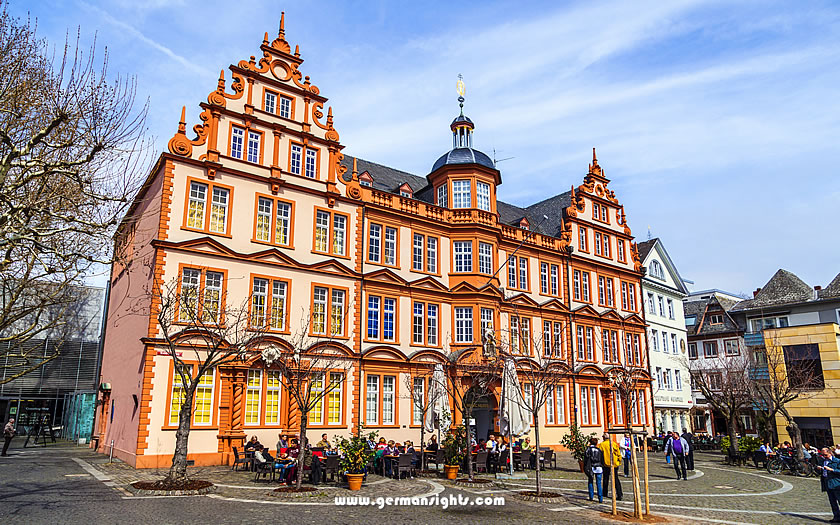
The Gutenberg Museum in Mainz
This Gothic church is well-known for its impressive stained glass windows, which were created by Marc Chagall. The nine windows, made between 1978 and 1985, feature scenes from the Old Testament and bathe the space in an otherworldly blue glow. Visitors can enjoy sweeping views of Mainz from the church's elevated location.
Mainz's Old Town is a great place to explore. It's full of narrow streets lined with half-timbered houses and some lovely squares. The Kirschgarten square is a particularly beautiful spot, and there are also some great shops and cafés on the Augustinerstraße.

The Kirschgarten square in the Mainz city centre
The Roman-Germanic Central Museum ('Römisch-Germanisches Zentralmuseum') is located in the Electoral Palace and has a huge collection of artefacts from prehistoric times to the early Middle Ages.
It's particularly known for its Roman exhibits, including reconstructions of Roman military equipment and everyday objects, offering an insight into life during the Roman occupation of the region.
This museum is housed in a former electoral palace and covers the cultural history of Mainz and the surrounding region.
Its diverse collections include Roman artefacts, medieval sculptures, Renaissance and Baroque paintings, and modern art, with the Roman section featuring the largest collection of Roman stone monuments north of the Alps.
Schillerplatz is a central square named after the German poet Friedrich Schiller.
The main attraction is the Fastnachtsbrunnen, which translates as the Carnival Fountain. It's a large fountain with over 200 figures made of bronze. The figures show scenes and characters from the city's famous carnival.
It's a great example of the city's lively carnival traditions and a popular meeting place.
This riverside walkway is great for taking in the scenery of the Rhine and it's a firm favourite with locals and tourists alike. It's the perfect spot for relaxing with a drink while watching boats go by. In summer, it's often the venue for festivals and outdoor events.
There's plenty to explore in Mainz itself, but its location in the Rhine Valley makes it a great base for day trips to nearby attractions. Here are some of the best trips to consider during your stay in Mainz:
The UNESCO World Heritage Upper Middle Rhine Valley is a must-visit area, and it's easy to get to from Mainz.
Lorelei Rock: This legendary slate rock formation, steeped in folklore, offers stunning views of the Rhine. To fully appreciate the dramatic landscape, take a river cruise from Mainz.
Rheinstein Castle: This restored 14th-century castle perched above the Rhine provides a glimpse into medieval life and offers panoramic river views.
Rhine River Cruises: Several companies offer day cruises from Mainz, allowing you to enjoy the picturesque towns, vineyards, and castles along the river.
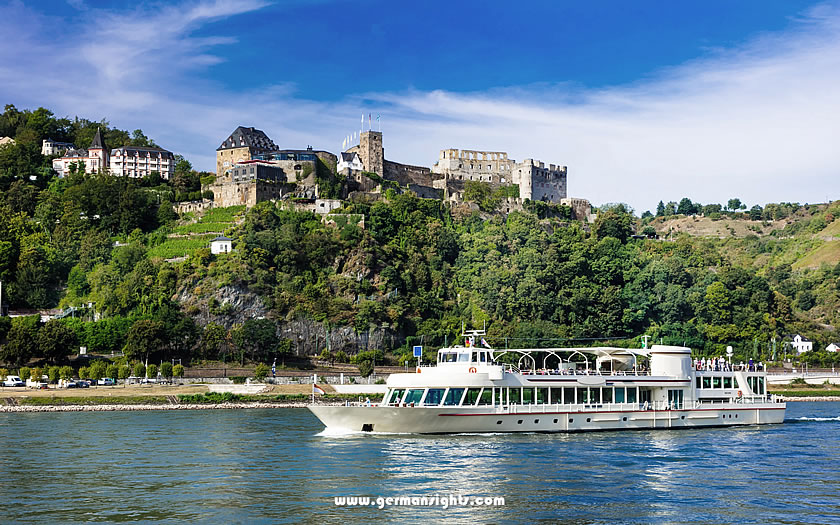
A Rhine river cruise passing Rheinfels castle
The city of Mainz is surrounded by some of the most renowned wine regions in the country, making them the perfect destination for a day trip.
Rheinhessen: Germany's largest wine region is right at Mainz's doorstep. Visit charming wine villages like Nierstein or Oppenheim for cellar tours and tastings.
Rheingau: Known for its Rieslings, this region offers beautiful landscapes and historic wineries. Don't miss the Eberbach Abbey, a former monastery turned winery.
Vineyards Tour: Join a guided tour to explore multiple vineyards and learn about the region's winemaking traditions.
Here's a quick rundown of some nearby towns and cities:
Wiesbaden: Just across the Rhine, this stylish spa town is home to some gorgeous Belle Époque architecture, thermal baths and a world-famous casino.
Rüdesheim am Rhein: A lovely wine town known for its Drosselgasse, a narrow lane filled with shops and wine taverns. You can take the cable car up to the Niederwald Monument for spectacular views.
Frankfurt: This bustling city is less than an hour away. It offers a stark contrast with its modern skyline, world-class museums, and lively urban atmosphere.
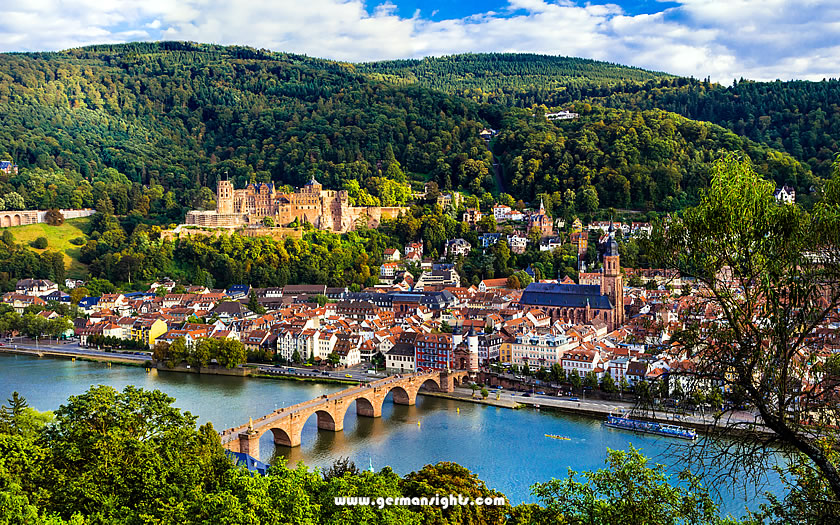
A view over Heidelberg in southwestern Germany
Heidelberg: The romantic university town, with its iconic castle ruins and charming old town, is a great place to spend the day.
Mainz is a city that knows how to celebrate, with lots of festivals and events on its calendar that showcase the city's cultural heritage.
The Mainz Carnival, or Mainzer Fastnacht: The highlight of Mainz's festival season, this centuries-old celebration is a feast for the eyes, ears, and soul. The carnival is held in the run-up to Lent and turns the city into a hive of activity with parades, costume balls and street parties. Visitors can look forward to seeing some impressive floats and traditional costumes, as well as experiencing the unique "Narrhallamarsch" carnival march.
Johannisnacht: This midsummer festival is a celebration of Johannes Gutenberg, who was born in Mainz and is still regarded as the city's most famous son. There are book markets, live performances and a spectacular fireworks display over the Rhine, so Johannisnacht offers a perfect blend of culture and entertainment.
Mainz Wine Market: As the capital of one of Germany's top wine regions, Mainz puts its viticultural heritage on full display. This annual event in the city's lovely Stadtpark features over 100 local wines, along with regional cuisine and live music.
Mainzer WeinUfer: This relatively new week-long festival in the spring is another must for wine lovers. It transforms the Rhine promenade into a wine-tasting paradise.
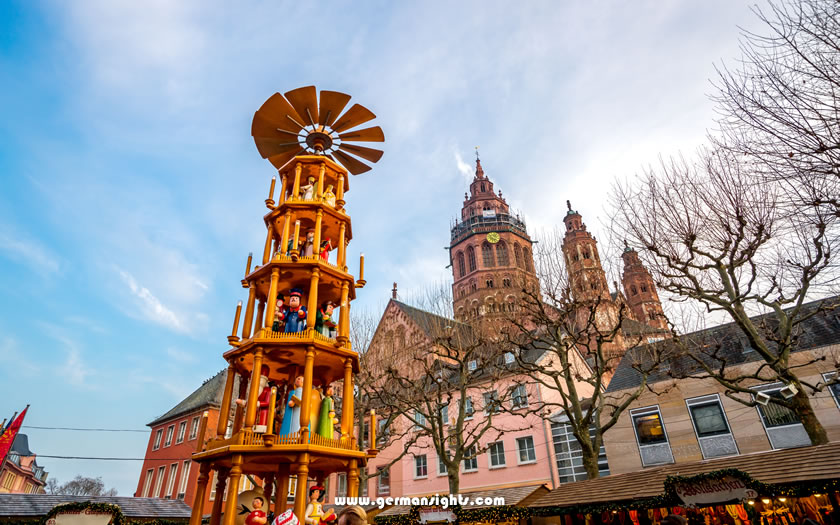
The Christmas market in Mainz
Mainz Christmas Market: The Christmas market opens during the Advent period on the Market Square ('Marktplatz') near the cathedral in the old town.
The tourist information office in Mainz is known as mainz STORE. It is located on the Marktplatz (the 'Market Square') next to the cathedral (also known as Domplatz/Cathedral Square) and is open six days a week from 10.00-18.00.
As well as providing information about the city and surrounding area, the building also houses an exhibition area and a souvenir and wine store.
Tourist Office: www.mainz-tourismus.com